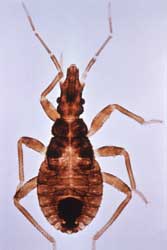"Traveling salesman problem" applied to Chagas, may also help combat dengue and malaria
January / February 2010 | Volume 9, Issue 1

Photo courtesy of Dr. Michael Levy
Fogarty scientist Dr. Michael Levy and
colleagues used the traveling salesman
problem to improve insecticide application
strategies to combat Chagas disease in
Peru.
The classic "traveling salesman problem" has been successfully applied to address Chagas disease in Peru, increasing the effectiveness of insecticide application and reducing transmission of Chagas, which is spread through bug bites. Researchers believe the strategy may also work for other vector-borne diseases such as dengue and malaria.
Fogarty scientists Drs. Michael Levy and Ellis McKenzie - together with their collaborators - recently published their findings in the Journal of the Royal Society Interface.
Levy and his colleagues knew the traditional contiguous approach to insecticide application, spraying one adjoining area after another, does not work well in urban settings such as Arequipa, the study site. They looked for a more effective approach and decided to explore the traveling salesman problem, a standard exercise in operations research and theoretical computer science. Solving the problem requires covering a defined territory without retracing steps, minimizing the total distance traveled. A rich library of traveling salesman algorithms exists but had never been adapted to infectious disease control.
The team tested a multitude of ways to reduce the reach of Triatoma infestans, the bug that carries Chagas. They had to diminish re-infestation in areas treated with insecticide, combat waning insecticide effectiveness, maximize limited resources and adjust for delays caused by finances, weather and labor.

Image courtesy of CDC/WHO
The Triatoma infestans, or
'kissing bug,' is responsible
for Chagas disease, which
affects millions in South and
Central America.
Levy and his colleagues analyzed the conditions under which certain tactics improve control, studying the properties of 1,000 algorithm-generated strategies. They developed a mathematical model that calculates the expected number of instances of re-infestation from active dispersal. They used this model to evaluate control strategies based on the rule of continuity (in time) and contiguity (in space).
With this model they identified a new more strategic insecticide application plan and found it would reduce insect re-infestation 34-fold. This concept may also be effective in combating other vector-borne diseases such as dengue and malaria, the researchers suggest. Their work will help guide an insecticide application campaign by the Peruvian Ministry of Health and the Panamerican Health Organization, with funding from Canada.
Chagas disease, named for Brazilian physician Carlos Chagas who discovered it in 1909, causes untold misery. Difficult to diagnose, it is the leading cause of heart attacks and kills more people in South and Central America than any other parasitic disease. Between 8 and 10 million individuals are estimated to be infected.
The kissing bug, Triatoma infestans, got its nickname from biting victims near their mouths. The bite is just the beginning: this insect sucks blood and then defecates on top of the site, causing itching and the infection.
The disease attacks muscle cells, destroying heart tissue and the gastrointestinal tract. Two available drugs come with significant side-effects and a 50/50 cure rate. In January, there was another hopeful development in the fight against Chagas. Researchers at the University of San Francisco announced they are applying for FDA approval to test a protease inhibitor that could be a safe and effective cure.
More Information
To view Adobe PDF files,
download current, free accessible plug-ins from Adobe's website.